Kurzel’s Macbeth: Aesthetics of a War Drama
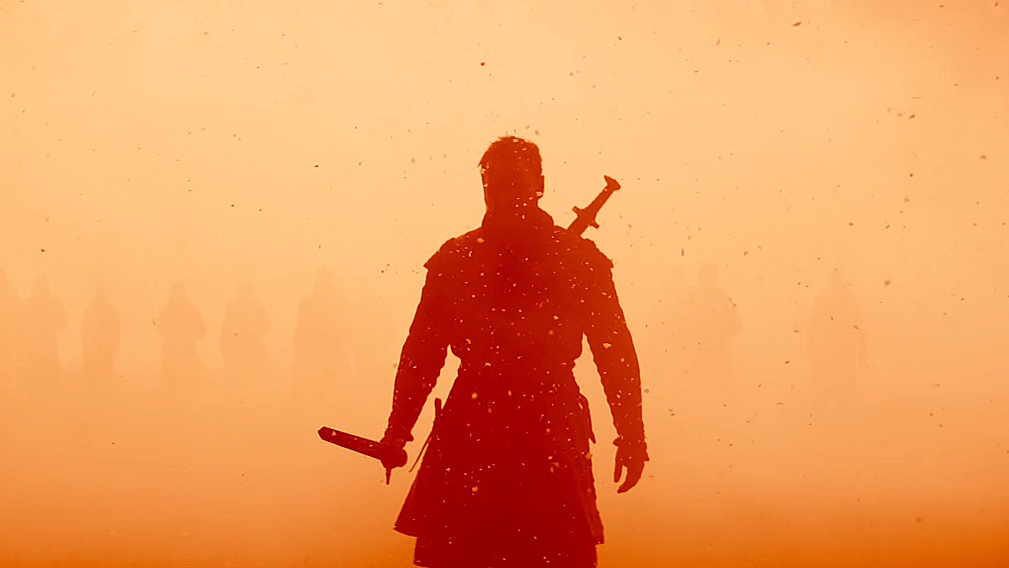
(SPOILERS)
Justin Kurzel’s third directorial odyssey–an adaptation of Shakespeare’s Macbeth–is a glorious and fulfilling show of artful period-piece aesthetics. It is a visual feast of rich color and vast mystic landscapes scoped by a haunting tone in nearly every shot. Adam Arkapaw, the cinematographer who worked with Kurzel on Macbeth, won two awards for his work: the Spotlight Award from the American Society of Cinematographers, and the Silver Camera award from the Brothers Manaki International Film Festival. Macbeth is an example of some of the most visually striking, beautiful, and immersive cinematography ever seen in a Shakespearean adaptation, and film in general. Kurzel’s Macbeth was also nominated for the Palme d’Or at the Cannes Film Festival. This article will examine the cinematography, directorial choices of the film, why they work so well, and why they matter.
The Portrayal of Violence
From the opening war scene to the Macbeth-Macduff duel finale, violence is a key player in the film (and story). Kurzel and Chris Dickens (editor) crafted the opening war scene with seamless and gritty camera work to create a sense of hyper realism. The use of extreme slow motion, intercut with brutal war violence (shot at a high shutter speed) contrasts the gritty realism with an element of fantasy–thus creating an extremely dynamic element to the film, complimenting to the story’s very dynamic themes.
Kurzel is famous for his portrayal of very real and disturbing violence from his work on The Snowtown Murders (2011), a story of psychological trauma and filth which was awarded the President’s Special Mention at the Cannes Film Festival. Beautifully thick and grimy make-up is used throughout all of the film and adds very much to its grit. There is amazing sound design and editing used in the film as well–often as a catalysts to propel the audience into the insanity of war. The slow motion scenes in particular, when the sound is cut, only plays a muffled roar from the men yelling, to cut back into real-time with the roar being heard regularly again. The beginning war scene does this back and forth, creating a sort of tension-release practicum for the audience to become more invested in these intense moments. Sharp sword cuts and slices with low, deep thuds and clangs form a highly convincing sound design and enhance the details of world-building in the film.
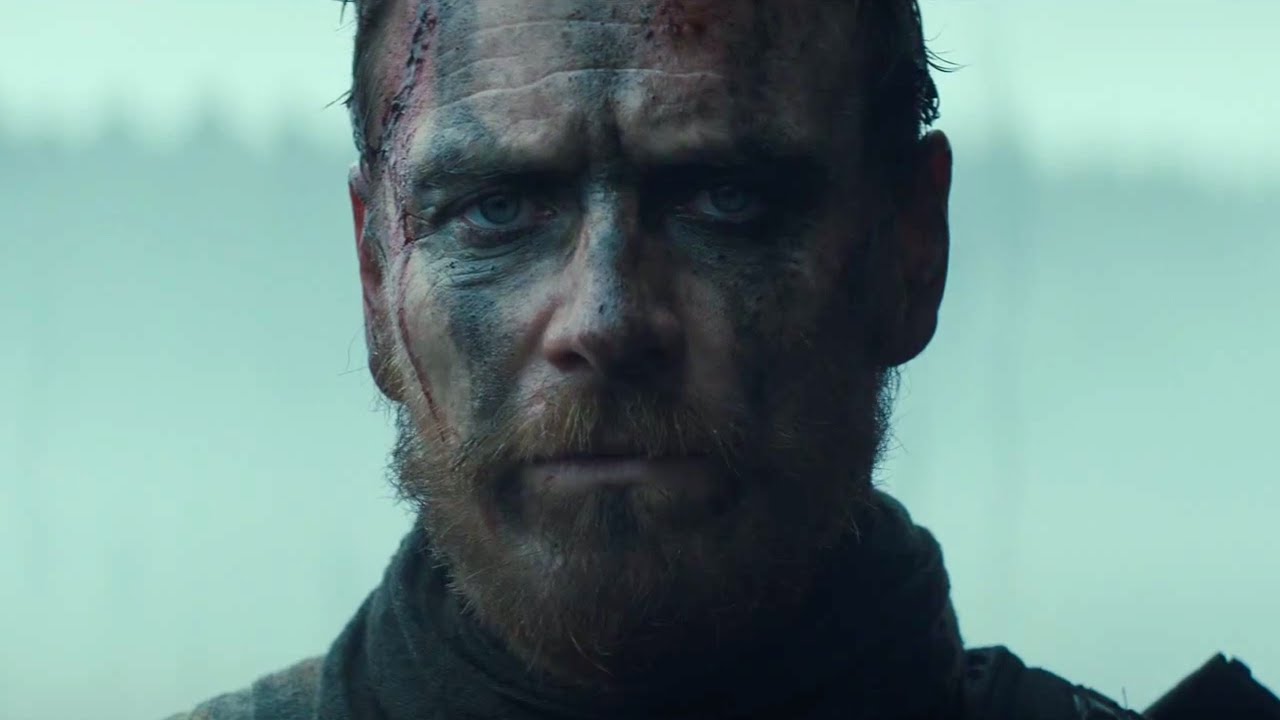
To implore the psychological torment of the story’s characters, Kurzel showed in full the brutality of the violence in the film, that wrought these troubled minds–whether it be in the war scenes, or when Macbeth kills Duncan, perhaps when Macbeth later kills the innocent guards Lady Macbeth framed, or even when Macbeth organizes Banquo’s murder–all of the violence in the film is disturbing to watch due to its gritty aesthetic. Unlike much of the rest of the film, most of the violence scenes use no voice over in them. Many of the prepositional plot points and scenes of the main characters descending into insanity, voice over and cutting between locations and time are key components in bringing them to life. In the war scenes, however, there is virtually no voice over, or inter-cutting. This makes the audience feel as though it’s real–almost separate from the film’s more fantastical elements–making it seem to be in ‘real time’ and actually happening, thus intensifying it.
The final battle scene in the film, between Macbeth and Macduff, is a visual feast to say the least. The scenes are flooded with a pallet of bright reds, whites, yellows, oranges, and rich blacks. Adam Arkapaw likely shot the film in an anamorphic format to get the very strange and stylized lens flares seen throughout this battle. What helps make this (and all the exterior shots) seem so dynamic to watch, is the use of ash and smoke against the harsh sunlight. The glowing ash embers and cloudy dark smoke all through the air makes these wide exterior shots feel almost claustrophobic and haunting–a choice by Kurzel to add to both the spiritual feel of the climax in the story, and it’s more realistic elements of grit.
The Portrayal of Marriage and Insanity
There are three scenes in particular (that are all compositionally related to each other) in which Kurzel makes the utmost precision to frame and visually show the the complicated relationship between Macbeth and Lady Macbeth in a dynamic way.
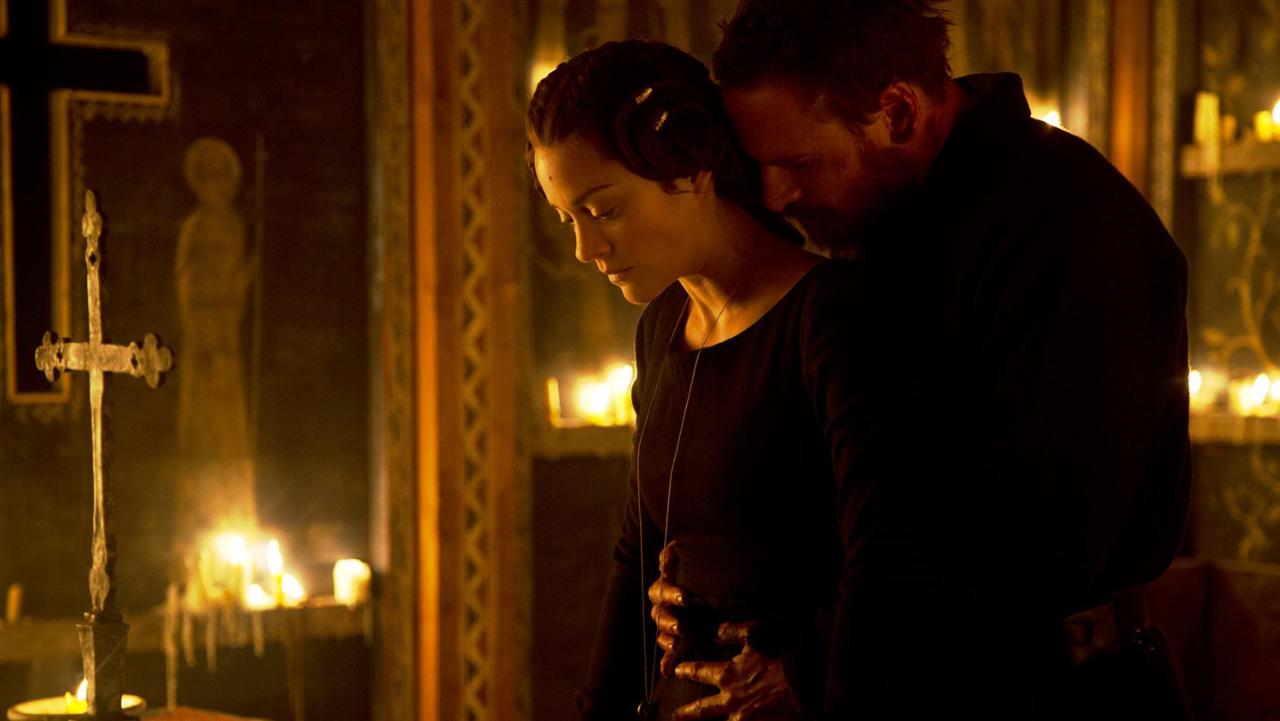
The sexual tension between the two protagonists levels on the mysticism and insanity like the rest of the film. Macbeth is shown to descend into madness, and descend into a brute carnal nature toward his wife, while Lady Macbeth is shown to use sexuality as a manipulative tool. Lady Macbeth initiates intercourse with Macbeth which instructing him that it would be wise, if not obligatory, for him to murder Duncan. Preceding climax, Macbeth seems to be convinced. Later on in the film, Macbeth almost does the same to Lady Macbeth. While indulging in his madness, preceding his proclamation: “full of scorpions is my mind,” Macbeth–sitting across from Lady Macbeth–moves his hand under her dress and between her legs. Lady Macbeth seems to be frightfully repelled by this, but nonetheless taken by what he has to say. This disturbed mania would reach its apex between the couple when Macbeth makes a public scene of insanity at the feast when he sees the ghost of Banquo there.
Two scenes that precede Duncan’s murder, and one scene soon following it, all compose Lady Macbeth and Macbeth in similar ways. The first two show Lady Macbeth on the right side of the frame, Macbeth barely in the far right, and a candle light in the left in the background (perhaps insinuating that Lady Macbeth has other motives to her temptations towards Macbeth/she has other things in the back of her mind). Macbeth is shown more center screen with Lady Macbeth slightly to his left (as in she’s the only thing he thinks about in these times–her word to him). They also feature Macbeth slightly towering over Lady Macbeth. After the murder, however, the composition is reversed. Lady Macbeth is almost always towering over, or even holding Macbeth. And she is shown in center frame while Macbeth is continuously shown in the edge of the frame, often in a contorted position. This is Kurzel’s visual telling of Macbeth’s descent. The proportion to center frame is relative to the character’s psyche–the more obtuse the framing, the most estranged they become.
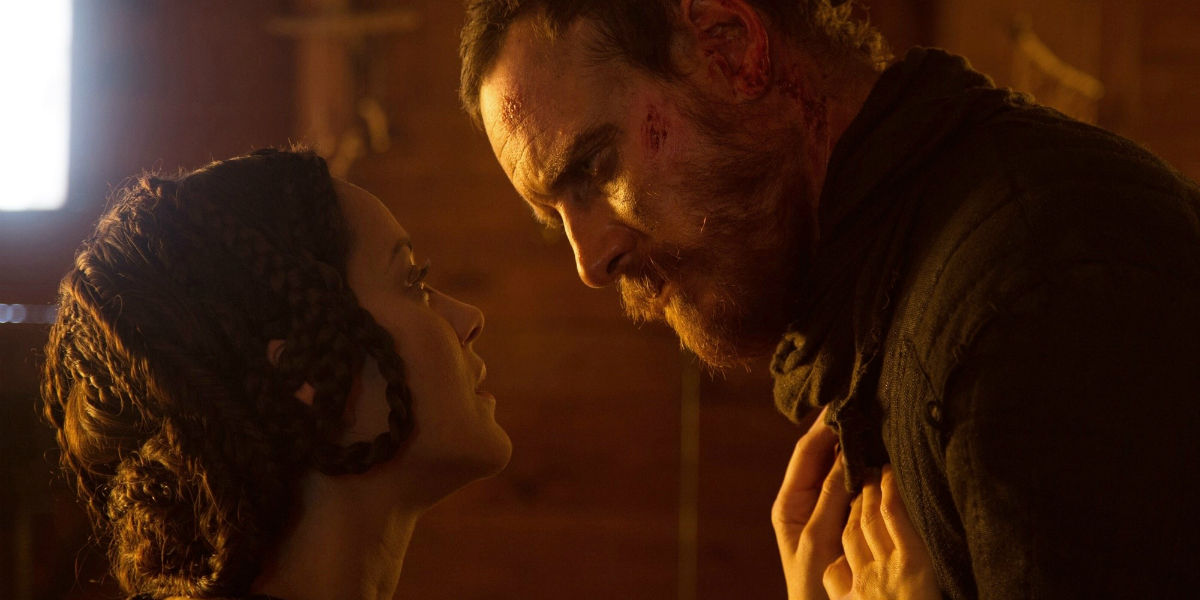
Kurzel shows great artful subtly when he shoots arguably the most estranged scene in the whole film, in which Macbeth grabs Lady Macbeth’s dead body and quasi-dances with it while reciting his sound and fury monologue. There is no fancy composition or camera work done in the scene, we simply track Macbeth. This is not, however, an example of Kurzel’s laziness–rather, an example of his repose. Such a powerful scene would almost be hindered by flaunting it with some kind of visual technique. A much more powerful approach is to keep everything still–right on the characters and what their doing, so that the audience can derive their own estrangement from it. Quentin Tarantino employed a similar technique in his film Reservoir Dogs, where he would actually move the camera away from some of the torture scenes, to let the audience derive the content in their own minds.
The Portrayal of Mysticism
So foul and fair a day. The story of Macbeth is riddled with spiritual entities and ideas of Amor Fati. Every single exterior shot in the film feels like a glimpse into death’s dream kingdom. Every landscape is captured with light, fog, and clouds to convey a disarranged sense of curiosity in a vast meadowland of malfeasance.
This aesthetic consists of highly contrasting, rich colors, and hyper-dynamic camera movement. The entire film was shot handheld, with some tripod/establishing shots as well. Most of the time–when the camera is handheld–the audience feels the sense of a jittery, hyper-fierce essence to whatever is happening. It’s very crooked, and very violent; letting the audience experience the brute nature in this ‘place’ of the story. The tripod and establishing shots, however, do an excellent service to the film by constantly layering the audience with grandeur compositions. Nearly every establishing shot in the film that contains armies, large groups of people, or villages, all do an excellent job in capturing the force and weight of their portraits.
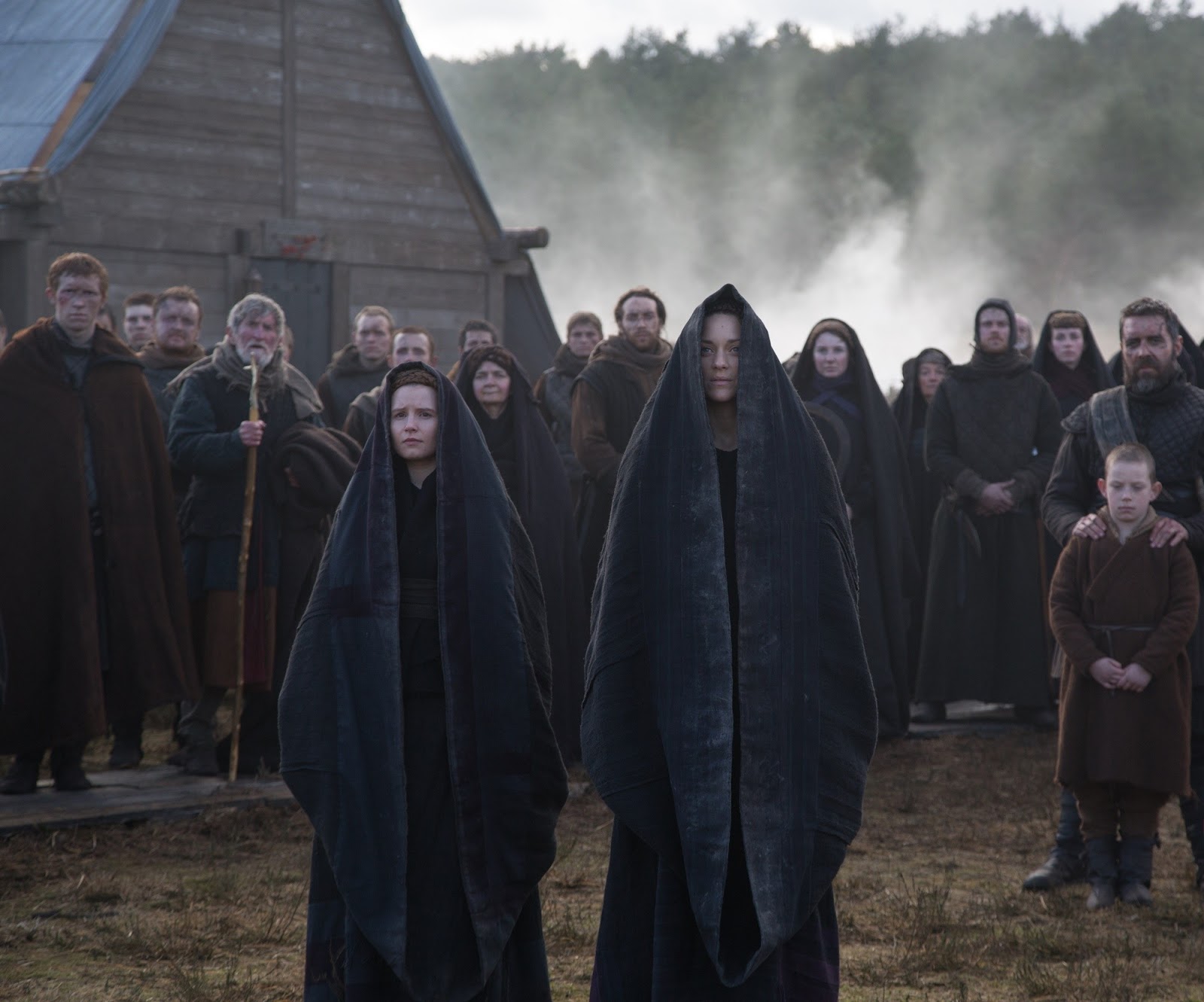
The interior scenes, especially those in chapels and castles, are lit in a way to convey a vintage hue. Light often beams through windows or crosses in the walls that project shaped light throughout the entire building(s). There is often very spectacular architecture blended with golden lens flares from throne-like candles, especially in the final sequence(s).
Another notably extreme scene in which Macbeth burns Macduff’s family at the stake–does two things extremely well: it conveys the looming contrast of Macbeth’s evil over the land (through color), and it highlights Lady Macbeth’s horror of this evil. The scene starts off with a horrific outburst from Lady Macduff about Macbeth. From there, Kurzel pans from a wide angle shot of a vast blue ocean, over to the glowing embers of the three stakes on fire. The fire illuminates everything around it–gleaming (consumed) in the eyes of all those present, especially Lady Macbeth. All the shots of Lady Macbeth have a rich blue-bright red contrast to visually show her psychological dichotomy of right and wrong, and if there’s even a world which could have changed from this situation she finds herself in.
Themes on the Screen
What’s so astounding about this amazing adaptation, is that it fully implores the thematic content of Macbeth, in a visually comprehensive way–while also imploring foreign aspects of the story (since the screenwriters changed a few things from the original story, and added new things to it as well). Both Michael Fassbender and Marion Cotillard excel in portraying psychologically tormented individuals who collapse under the weight of themselves, and Kurzel brilliantly conveyed that on screen.
Kurzel’s Macbeth is a dazzling visual exploration into the thematic material from a master playwright. With some of the most astounding cinematography, acting, and visual aesthetics in recent years. Macbeth deserves a ranking as one of the great 21st century American period piece art films, and one of the greatest Shakespeare adaptions ever.
“Life’s but a walking shadow, a poor player that struts and frets his hour upon the stage and then is heard no more: it is a tale told by an idiot, full of sound and fury, signifying nothing.” Act V, Scene V
What do you think? Leave a comment.











Great article! A fresh look at an often written about topic. But you have added a different perspective.
I will admit that I am not a fan of Shakespeare and I have not seen any other adaptations of Macbeth, but I enjoyed this one, it is very nicely acted and filmed.
My best “Macbeth” still remains the Orson Welles version, followed by Kurosawa’s “Throne of Blood.”
I’ve always enjoyed Throne of Blood, and this sounds and looks like a great adaptation too. 🙂 Excellent analysis.
interesting visuals and fine performances in this one
While this is not quite as good as Roman Polanski’s 1971 version, it’s definitely worth watching. Good analysis.
I was expecting this movie to be a modern day version of this all time classic but the director chose to stick with Shakespeare’s words, which got on my nerves from the beginning to the end.
I feel that this could’ve been a great movie had it had another story altogether.
The best thing about this movie is the music.
It was a visually stunning film and I loved the classic setting.
I’d like to see the author of this article write about one of my favourite adaptions of Shakespeare: Ran.
Great cinematography.
This is a very good adaptation of Macbeth.
Old English. Oh how i despise you. For those who do not have English as its mother language, you will have to resort to reading subtitles all the time, which is annoying (and for those who do, you will have to bring a dictionary with you).
The plot is great but poorly presented, and Michael Fassbender does a fantastic job for about 1/3 of this movie.
I love the story of Macbeth. I think that the plot is really good. It’s interesting and it could be awesome if done right. Unfortunately I’m not a fan of Shakespeare, or at least how he writes. His stories are interesting, but when you can’t understand a single word it makes it hard to truly appreciate how good his plays are. I’ve been wanting a Shakespeare movie adaptation with more modernized language, and unfortunately this wasn’t the one.
Marion Cotillard is amazing always.
Fassbender is not the best Macbeth–others have been a lot better.
Very detailed and well-thought out analysis…loved the narrowing in on technique and cinematography as a centre point…very refreshing read!
A nicely focused paper that is able to take a fresh take on Shakespeare in film by looking at the film in itself, without layering it with reference to the stage, history, or even previous film adaptations.
An important Shakespeare film.
Very interesting analysis. I think Kurzel’s “Macbeth” is a beautiful piece of cinema. By most accounts, it’s pretty difficult to do the Bard justice on the big screen, but even my dad – a retired English teacher and walking Shakespeare textbook – liked this adaptation. His only issue was the shortening of some of the dialogue.
I like what I see of this version. There are multiple versions of The Scottish Play for film.